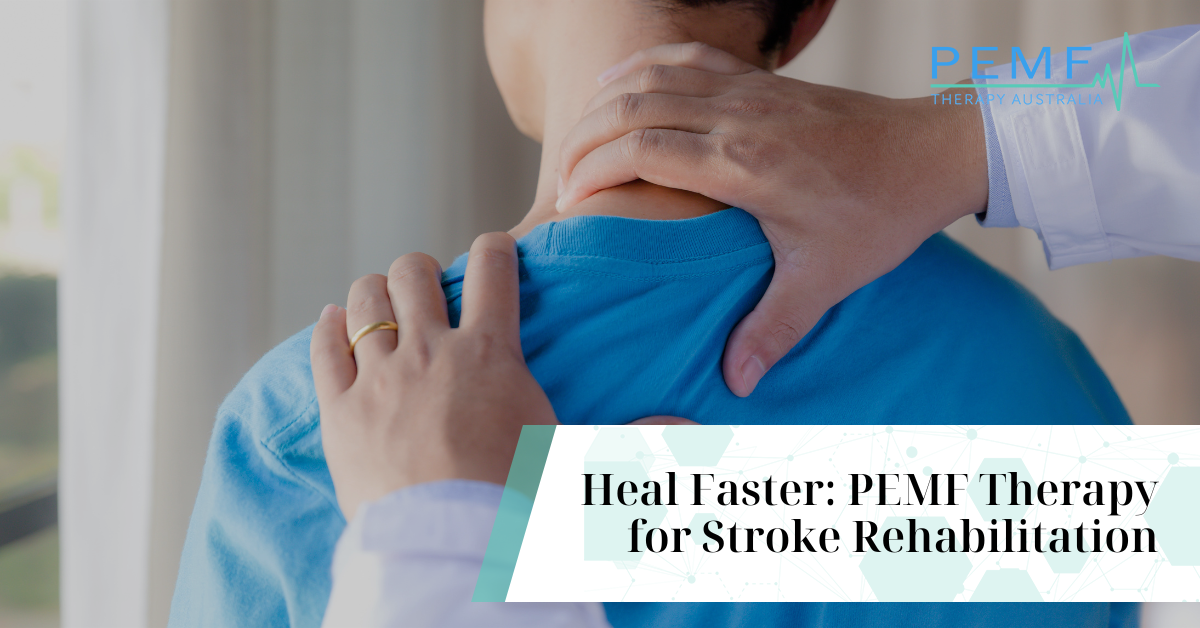Stroke recovery can feel like climbing a mountain, one small step at a time. With so much focus on traditional methods like physical therapy and medication, people often overlook relativelynew technology, which is backed by clinical studies. One of the most exciting innovations in stroke care today is PEMF therapy , a cutting-edge treatment that helps the brain and body heal faster by recharging damaged cells.
Strokes can have a devastating impact on movement, speech, and even emotions. For many, getting back to a normal life feels like a long shot. But what if there was a way to support your body’s natural recovery systems and cut down on recovery time? That’s exactly what PEMF therapy aims to do. By helping improve blood flow, reduce inflammation and repair damaged tissues, this therapy is emerging as a game-changer in stroke rehabilitation therapy.
If you’re looking for innovative ways to support healing and regain strength, PEMF for stroke could be the solution you’ve been searching for. Below, we’ll delve deeper into how this therapy works, why it’s so effective, and how it can become a key part of your recovery plan.
What is PEMF Therapy?
PEMF stands for pulsed electromagnetic field therapy, a non-invasive treatment that uses electromagnetic waves to stimulate and repair cells. The therapy sends low-frequency energy waves deep into the body. These waves energise your cells, helping them function better, repair themselves, and regenerate tissue.
Think of your body as a rechargeable battery. After a stroke, your cells lose energy, making it harder for them to heal. PEMF works like a cellular charger, giving your cells the energy they need to recover. That’s why it’s especially helpful for stroke healing therapy, where damaged tissues need extra help to repair and regenerate.
Research shows PEMF therapy can improve blood circulation, reduce inflammation, and stimulate the brain’s natural healing processes. These effects make it a strong candidate for anyone looking to enhance their recovery journey.
Why PEMF is Ideal for Stroke Rehabilitation
Stroke leaves lasting effects on the brain and body, from paralysis to memory loss. Traditional therapies like physical and occupational therapy address symptoms, but they don’t directly help the damaged cells that caused those symptoms. That’s where PEMF steps in—it targets the root cause.
Here’s why PEMF stands out for stroke recovery:
- Improves blood flow: Strokes disrupt oxygen and nutrient delivery to the brain. PEMF increases circulation, allowing the brain to heal faster.
- Stimulates nerve repair: Strokes damage neurons, which are responsible for communication between the brain and body. PEMF encourages these neurons to regenerate.
- Reduces inflammation: Swelling in the brain after a stroke can slow recovery. PEMF helps reduce this inflammation, speeding up the process.
For anyone in stroke rehabilitation therapy, adding PEMF to your plan can make a noticeable difference. It doesn’t replace traditional methods but works alongside them to enhance your results.
How PEMF Therapy Supports Stroke Recovery
Stroke recovery can feel like a waiting game, but PEMF accelerates progress in several key ways:
- Revives damaged cells: After a stroke, brain cells are starved of oxygen and energy. PEMF therapy re-energises these cells, giving them the tools they need to heal.
- Restores mobility: Many stroke survivors struggle with paralysis or muscle weakness. By improving nerve-to-muscle signals, PEMF helps restore motor function faster.
- Eases emotional challenges: Beyond physical symptoms, strokes often cause anxiety or depression. PEMF has a calming effect on the brain, promoting emotional balance.
These benefits make PEMF an effective addition to any stroke recovery treatment plan. It not only speeds up healing but also makes the process more manageable.
Benefits of PEMF Therapy for Stroke Patients
PEMF therapy offers a wide range of benefits for stroke survivors. It’s not just about improving physical health; it also supports emotional well-being and overall quality of life.
Here are some of the key PEMF benefits for stroke patients:
- Non-invasive and painless: There’s no need for surgery or medication. The treatment is gentle and easy to tolerate.
- Speeds up recovery: Many patients report noticeable improvements in weeks, not months.
- Customised to your needs: Different frequencies can target specific issues like inflammation, pain, or movement problems.
Unlike traditional therapies that take time to deliver results, PEMF often provides faster relief. It’s also safe to combine with other treatments, making it an excellent choice for holistic PEMF rehabilitation.
The Science Behind PEMF Therapy
What makes PEMF therapy so effective for strokes? The secret lies in its ability to target cells on a deep level. When a stroke occurs, the brain is cut off from oxygen and nutrients, causing damage to brain cells. PEMF stimulates these cells by boosting their voltage levels, allowing them to repair themselves more quickly..
Here’s how PEMF works:
- Electromagnetic waves penetrate tissues: These waves pass through the skin, reaching deep into the body without causing harm.
- Cell activity increases: PEMF enhances cell function by improving how they process energy.
- Healing begins: With better-functioning cells, the brain and body can start repairing damaged areas.
This makes PEMF an ideal stroke healing method. It doesn’t just treat the symptoms; it works at the cellular level to heal the underlying damage.
What to Expect from PEMF Therapy
If you’re new to PEMF, you might wonder what it’s like. The process is simple, painless, and easy to fit into your routine.
Here’s a quick overview:
- Preparation: A therapist places electromagnetic coils on or near the affected areas.
- Session: The PEMF device delivers low-frequency pulses, which may feel like a gentle warmth or slight tingling.
- Duration: Most sessions last 30-50 minutes, though this can vary depending on your condition.
Patients often report feeling relaxed and energised after treatment. Over time, these sessions can lead to significant improvements in both physical and emotional health.
FAQs
1. Is PEMF therapy safe for stroke survivors?
Yes, PEMF is non-invasive and safe when used by trained professionals. It doesn’t involve any harmful chemicals or invasive procedures.
2. When should I start PEMF therapy after a stroke?
It’s best to start as soon as your condition stabilises. Early treatment often leads to better outcomes. Consult your doctor for guidance.
3. How many sessions are needed for stroke recovery?
The number of sessions depends on the severity of your stroke and your recovery goals. Some patients see improvements within a few weeks, while others may require longer treatment.
4. Can PEMF therapy replace physical therapy?
No, PEMF works best as a complementary treatment. It enhances the results of traditional therapies like physical and occupational therapy.
5. Are there any risks or side effects?
Side effects are rare. Some patients may feel mild fatigue or dizziness after the first session, but this usually fades quickly.
Start Your Stroke Recovery Journey Today
Recovering from a stroke doesn’t have to be an uphill battle. PEMF therapy offers a powerful way to boost your progress, restore mobility, and regain your quality of life. By targeting the root causes of cell damage, PEMF accelerates healing and supports both physical and emotional recovery.
If you or a loved one are exploring options for stroke recovery, it’s time to consider PEMF. This innovative therapy is safe, effective, and backed by science. To learn more about how PEMF can transform your recovery journey, visit PEMF Therapy Australia. Make an appointment now or look at renting a system here and take the first step towards better health!
Contact us today to learn more at 0452 527 284 or leave an enquiry.


